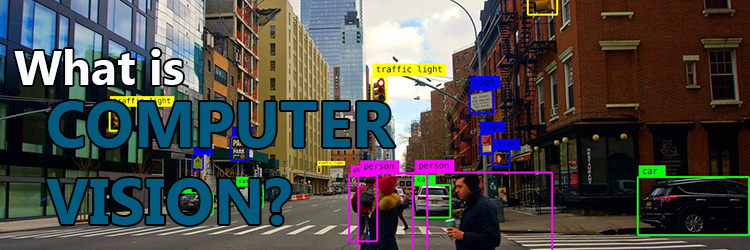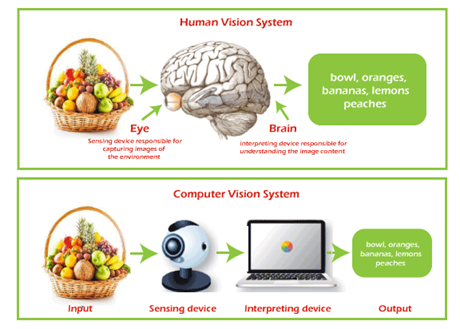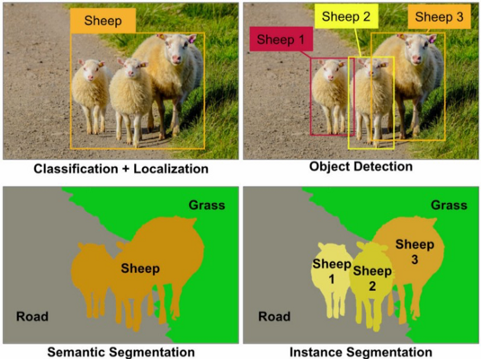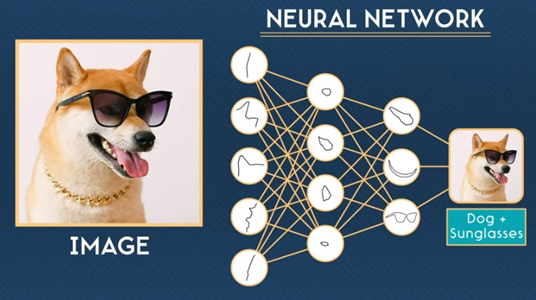
The advancement of Artificial Intelligence (AI) technologies and the growth of computational power change how people interact with machines. AI technologies enable computers to mimic human intelligence and perform human-like tasks. It allows computers to faster data processing and makes accurate decisions on time to make our lives easier and more convenient than ever. The main fields of AI include technologies such as Machine Learning, Deep Learning, Neural Networks, Cognitive Computing, Natural Language Processing, and Computer Vision. These technologies can use to reduce the gap between human and machine capabilities. Among them, Computer vision focuses on imitating the human eye to help machines to see the world.
What is Computer Vision?
Computer Vision is a field of Artificial Intelligence that enables computers to see, identify and process visual data (images and videos) in the same way that human vision does. It processes visual data at the pixel level and extracts meaningful information to take appropriate actions. Other AI technologies, including Deep Learning and Neural Networks, support computer vision to improve its capabilities.
In the human visual system, the eye captures images from the surrounding environment and sends signals to the visual cortex along the optic nerve. The brain processes these nerve signals and creates a mental image. Computer vision systems process visual data similarly to human vision. It uses sophisticated algorithms to train computers to perform human-like functions, but recent advancements enable computer vision systems to surpass human capabilities. Computer vision systems require many source images to be more effective. More than 3.2 billion images are uploaded to the internet daily basis. This large quantity of images with high computational power makes it possible for computers to train complex computer vision systems.
Humans identify objects in visual scenes through learning. The human brain extracts the features of an object like size, orientation, illumination, and perspective and remembers it. Two AI-based technologies, Convolution Neural Network (CNN) and Recurrent Neural Network (RNN) used by computers to train computer vision systems. CNN uses to create the leading computer vision algorithms. It takes images as inputs, extracts the features from them, and uses them to perform tasks such as image classification, recognition, segmentation, and retrieval. But, CNN is always used to process spatial data such as images and understands single images. A Recurrent Neural Network can understand sequences and time, and it uses to analyze sequential data such as texts and videos.

Image source: javatpoint.com
Computer vision algorithms use to recognize the objects in visual content. These are some of the standard computer vision techniques:
Image Classification
Image classification is the most straightforward computer vision technique that can perform. It takes images as inputs and classifies them into distinct categories. There are two types of image classification; binary classification and multi-class classification. A well-trained computer vision model can classify images with a high level of accuracy.
Object Detection
Object detection is the following technique after image classification. It allows computers to detect and locate objects in visual content. In this technique, a bounding box is used to point to the spatial location of the object, and annotation tools draw an imaginary rectangle around the object and put a label for it.
Object Tracking
After a particular object is detected, object tracking tracks the movement of that object as it moves through frames in a video or real-world interaction. Object tracking can be divided into two categories; generative and discriminative. The generative model identifies the object by its distinctive characteristics, and the discriminative model recognizes the difference between the object and the background.
Semantic Segmentation
Semantic segmentation tries to assign a class (building, animal, tree, road, car, etc.) to similar objects at the pixel level. It includes different instances of the same object in a single class. For instance, there could be different types of vehicles such as cars, buses, and bicycles in a video frame, and semantic segmentation puts all these vehicles under the same class. This technique is widely used in autonomous navigation.
Instance Segmentation
Like semantic segmentation, instance segmentation classifies the objects at the pixel level. Further, it can be classified similar types of objects into different categories. Therefore, instance segmentation can consider an advanced level of semantic segmentation. It generates more detailed outputs. For instance, if there are groups of people in visual content, first semantic segmentation could include them in a class called “persons.” Then instance segmentation classifies each individual in that visual content.

Image source: towardsdatascience.com
How does computer vision work?
In computer vision, computers can be trained to recognize objects no matter their size, symmetry, or rotation. To do that requires millions of training data and performing trial and error. For instance, some simple shapes can be used to train computers to see. At first, train the computer to identify a square shape object from a preset group of options. In the beginning, the computer does not know how to detect the correct object but performs just random guesses. After a few attempts, the computer can recognize the correct shape.
With every guess, the computer looks at each pixel in the surrounding pixels and tries to recognize patterns and make rules to help it guess. For instance, if the computer sees a row of orange pixels next to a row of white pixels, it can be identified as an edge. If the computer sees two edges oriented at a 90-degree angle, it can be a square. These identifications are not always correct, but constant learning builds a more confident object identification algorithm. The training data is used to make a statistical model, and when the data feed, that model is tuned and optimized to recognize the pictures. It is expected that the model will then be able to identify new images with the same accuracy.
Unlike basic shapes, real-world examples are not that simple and are more complex to process. Most complex images can be broken down into small, simple patterns. For example, an eye is made up of two arcs and some circles inside, and a wheel is made up of concentric circles and some radial lines. The computer recognizes the patterns in all these pixels using a neural made of many layers. The first layer of neurons takes pixel values as numerical inputs to identify edges. The following few layers of neurons take those edges and try to detect simple shapes. Finally, the computer puts it all together to understand.

Computer vision use cases
Computer vision is already integrated into many applications and industries today. These are some of the best use cases of computer vision.
Healthcare
Computer vision applications can be applied to the healthcare sector to expand the accuracy and efficiency of medical services and research. Medical image analysis is crucial to the diagnosis of health problems. Computer vision-based systems analyze medical images such as X-rays, MRIs, CT scans, ultrasound images, etc., to identify illnesses that are not impossible to detect from the human eye. It will cut down the excessive time medical professionals spend on diagnostic procedures. Computer vision is widely used in cancer detection to recognize abnormalities in the skin, breasts, lungs, etc. Other than image analysis, computer vision helps to improve the areas such as patient identification, brilliant operating facilities, medical research, healthcare safety, etc. Overall, computer vision supports the health sector in developing advanced medical treatments and offers a better patient experience.
Transportation
The futuristic vision of the transportation industry heavily depends on AI-based technologies like computer vision. It can be considered a core element in intelligent transportation systems and can be applied to develop modern, safe, and efficient transportation services. Computer vision systems are used in many areas in the transportation industry, including autonomous driving, traffic management, accident prevention, road traffic analysis, etc. Self-driving vehicles may be the most popular computer vision application in the transportation industry. It will help self-driving vehicles to timely detect other vehicles, objects, pedestrians, road signs, and traffic lights in their surrounding environment. Computer vision-powered CCTV cameras can also be used to analyze the traffic flow in urban areas for better traffic management.
Facial recognition
Facial recognition systems use the distinctive features of the human face for identification purposes. It is also one of the widely used biometric authentication methods today. In facial recognition systems, computer vision algorithms detect the facial features and send them to match against the database for authentication purposes. For instance, mobile devices use the front camera to extract the facial features of users and use them to unlock the devices. Facebook app has used computer vision to detect and tag Facebook users after uploading images.
Agriculture
Climate change, crop diseases, weed emergence, soil erosion, and infertile lands are a few challenges the agriculture sector is undergoing today. Big agriculture companies and small-scale farmers are focusing on adopting AI-based technologies to face those challenges and enhance the harvest. Computer vision systems use images from satellites and drones to monitor the crops and analyze the features of crops such as size, shape, color, and texture. Earlier, detection and counting fruits on trees was a time-consuming and labor-intensive manual process. Now, these processes can be optimized and automated using computer vision techniques. The automated fruit counting approach gives farmers the information required to forecast the harvest and plan harvesting schedules. Crop grading and sorting, automated pesticide spraying, and phenotyping are some other use cases of computer vision in agriculture.
Manufacturing
Computer vision is one of the crucial AI-based technologies that positively impact the manufacturing industry. It transforms time-consuming and costly operations into innovative manufacturing operations that ensure higher efficiency, quality, and productivity. For instance, maintaining a high standard of product quality is a vital factor in the manufacturing industry. Computer vision systems use high-quality cameras to identify the defects in production lines that are not visible to the human eye. Some of the best use cases of computer vision in manufacturing include automated product assembly, quality control, predictive maintenance, 3D vision monitoring, and workplace safety.
Reference:
Youtube.com – code.org




